Related Research Articles

Perissodactyla is an order of ungulates. The order includes about 17 living species divided into three families: Equidae, Rhinocerotidae (rhinoceroses), and Tapiridae (tapirs). They typically have reduced the weight-bearing toes to three or one of the five original toes, though tapirs retain four toes on their front feet. The nonweight-bearing toes are either present, absent, vestigial, or positioned posteriorly. By contrast, artiodactyls bear most of their weight equally on four or two of the five toes: their third and fourth toes. Another difference between the two is that odd-toed ungulates digest plant cellulose in their intestines, rather than in one or more stomach chambers as even-toed ungulates, with the exception of Suina, do.

Ungulates are members of the diverse clade Euungulata which primarily consists of large mammals with hooves. Once part of the clade "Ungulata" along with the clade Paenungulata, "Ungulata" has since been determined to be a polyphyletic and thereby invalid clade based on molecular data. As a result, true ungulates had since been reclassified to the newer clade Euungulata in 2001 within the clade Laurasiatheria while Paenungulata has been reclassified to a distant clade Afrotheria. Living ungulates are divided into two orders: Perissodactyla including equines, rhinoceroses, and tapirs; and Artiodactyla including cattle, antelope, pigs, giraffes, camels, sheep, deer, and hippopotamuses, among others. Cetaceans such as whales, dolphins, and porpoises are also classified as artiodactyls, although they do not have hooves. Most terrestrial ungulates use the hoofed tips of their toes to support their body weight while standing or moving. Two other orders of ungulates, Notoungulata and Litopterna, both native to South America, became extinct at the end of the Pleistocene, around 12,000 years ago.
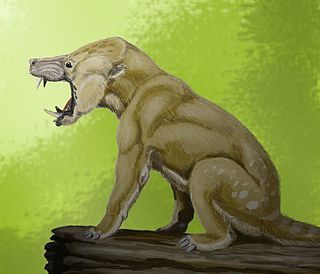
Condylarthra is an informal group – previously considered an order – of extinct placental mammals, known primarily from the Paleocene and Eocene epochs. They are considered early, primitive ungulates. It is now largely considered to be a wastebasket taxon, having served as a dumping ground for classifying ungulates which had not been clearly established as part of either Perissodactyla or Artiodactyla, being composed thus of several unrelated lineages.

Paraceratheriidae is an extinct family of long-limbed, hornless rhinocerotoids native to Asia and Eastern Europe that originated in the Eocene epoch and lived until the end of the Oligocene.
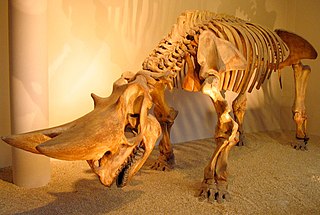
Embrithopoda ("heavy-footed") is an order of extinct mammals known from Asia, Africa and Eastern Europe. Most of the embrithopod genera are known exclusively from jaws and teeth dated from the late Paleocene to the late Eocene; however, the order is best known from its terminal member, the elephantine Arsinoitherium.

Phenacodus is an extinct genus of mammals from the late Paleocene through middle Eocene, about 55 million years ago. It is one of the earliest and most primitive of the ungulates, typifying the family Phenacodontidae and the order Perissodactyla.

South American native ungulates, commonly abbreviated as SANUs, are extinct ungulate-like mammals of controversial affinities that were indigenous to South America prior to the Great American Biotic Interchange. They comprise five major groups conventionally ranked as orders—Astrapotheria, Litopterna, Notoungulata, Pyrotheria, and Xenungulata—as well as the primitive "condylarth" groups Didolodontidae and Kollpaniinae. It has been proposed that some or all of the members of this group form a clade, named Meridiungulata, though the relationships of South American ungulates remain largely unresolved. The two largest groups of South American ungulates, the notoungulates and the litopterns, were the only groups to persist beyond the mid Miocene. Only a few of the largest species of notoungulates and litopterns survived until the end-Pleistocene extinction event around 12,000 years ago where they became extinct with most other large mammals in the Americas, shortly after the first arrival of humans into the region.
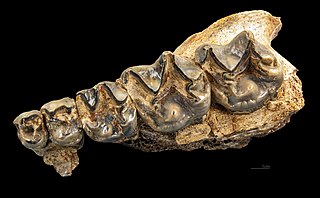
Chalicotherium is a genus of extinct odd-toed ungulates of the order Perissodactyla and family Chalicotheriidae. The genus is known from Europe and Asia, from the Middle Miocene to Late Miocene.
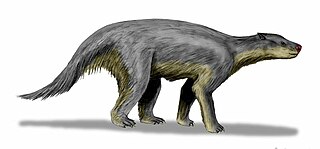
Pantodonta is an extinct suborder of eutherian mammals. These herbivorous mammals were one of the first groups of large mammals to evolve after the end of the Cretaceous. The last pantodonts died out at the end of the Eocene.
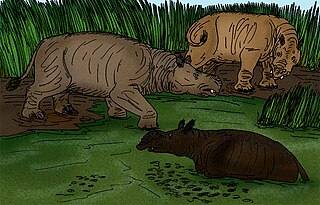
Amynodontidae is a family of extinct perissodactyls related to true rhinoceroses. They are commonly portrayed as semiaquatic hippo-like rhinos but this description only fits members of the Metamynodontini; other groups of amynodonts like the cadurcodontines had more typical ungulate proportions and convergently evolved a tapir-like proboscis.
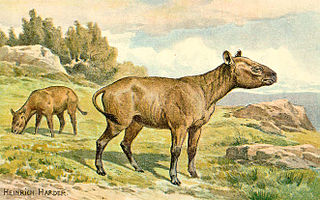
The Hyracodontidae are an extinct family of rhinocerotoids endemic to North America, Europe, and Asia during the Eocene through early Oligocene, living from 48.6 to 26.3 million years ago (Mya), existing about 22.3 million years.
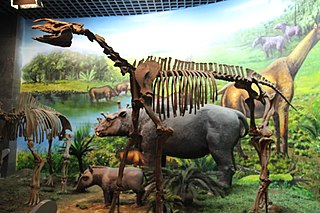
Juxia, ‘joo-she-a’, is an extinct genus of paraceratheriid, a group of herbivorous mammals that are related to the modern rhinoceros. The type species is Juxia sharamurenensis, named by Zhou Mingzhen and Qiu Zhanxiang in 1964. Juxia was around the size of a horse. It lived in Asia during the upper Eocene.

Tillodontia is an extinct suborder of eutherian mammals known from the Early Paleocene to Late Eocene of China, the Late Paleocene to Middle Eocene of North America where they display their maximum species diversity, the Middle Eocene of Pakistan, and the Early Eocene of Europe. Leaving no descendants, they are most closely related to the pantodonts, another extinct group. The tillodonts were medium- to large-sized animals that probably feed on roots and tubers in temperate to subtropical habitats.

Phenacodontidae is an extinct family of large herbivorous mammals traditionally placed in the “wastebasket taxon” Condylarthra, which may instead represent early-stage perissodactyls. They lived in the Paleocene and Eocene epochs and their fossil remains have been found in North America and Europe.

Altungulata or Pantomesaxonia is an invalid clade (mirorder) of ungulate mammals comprising the perissodactyls, hyracoids, and tethytheres.
Alcidedorbignya is an extinct pantodont mammal known from the Early Paleocene Santa Lucia Formation at Tiupampa near Mizque, Cochabamba, Bolivia.
Eggysodon is an extinct genus of odd-toed ungulate belong to the rhinoceros-like family Eggysodontidae. It was a small, ground-dwelling browser, and fossils have been found in Oligocene deposits throughout Europe. Eggysodon may have been related to Preaceratherium, and both had tusklike canines and smaller, and fewer, incisors.
Eggysodontidae is a family of perissodactyls closely related to rhinoceroses. Fossils have been found in Oligocene deposits in Europe, the Caucasus, Central Asia, China, and Mongolia.
Urtinotherium is an extinct genus of paracerathere mammals. It was a large animal that was closely related to Paraceratherium, and found in rocks dating from the Late Eocene to Early Oligocene period. The remains were first discovered in the Urtyn Obo region in Inner Mongolia, which the name Urtinotherium is based upon. Other referred specimens are from northern China.

Paenungulatomorpha is a clade of afrotherian mammals that can be characterized according to Gheerbrant et al. (2016):
by a mandibular retromolar fossa, the absence of hypocone, an ectoloph selenodont and linked to strong styles such as mesostyle in basal taxa, and a more or less developed pseudohypocone.
References
- Lucas, Spencer G. (2001). Chinese fossil vertebrates. Columbia University Press. ISBN 9780231084833 . Retrieved 14 April 2013.
- MacFadden, Bruce J. (2005). Janis, Christine Marie; Scott, Kathleen Marie; Jacobs, Louis L. (eds.). Evolution of Tertiary Mammals of North America: Terrestrial carnivores, ungulates, and ungulatelike mammals. Vol. 1. Cambridge University Press. ISBN 9780521355193 . Retrieved 14 April 2013.
- McKenna, M.C.; Chow, M.; Ting, S.; Luo, Z. (1989). "Radinskya yupingae, a perissodactyl-like mammal from the late Paleocene of China". In Prothero, D.R.; Schoch, R.M. (eds.). The evolution of perissodactyls. Oxford monographs on geology and geophysics. Vol. 15. New York: Oxford University Press. pp. 24–36. ISBN 9780195060393. OCLC 19268080.
- Prothero, Donald R.; Manning, Earl M.; Fischer, Martin (1988). "The phylogeny of the ungulates" (PDF). In Benton, Michael J. (ed.). The Phylogeny and Classification of the Tetrapods, Volume 2. Mammals. The Systematics Association Special Volume Series. Vol. 35. Oxford: Clarendon Press. pp. 201–34. ISBN 9780198577126 . Retrieved 14 April 2013.
- Prothero, Donald R.; Schoch, Robert M. (1989). "The origin and evolution of perissodactyls: a summary and synthesis" (PDF). In Prothero, D.R.; Schoch, R.M. (eds.). The evolution of perissodactyls. Oxford monographs on geology and geophysics. Vol. 15. New York: Oxford University Press. pp. 504–529. ISBN 9780195060393. OCLC 19268080 . Retrieved 14 April 2013.
- Prothero, Donald R.; Schoch, Robert M. (2002). Horns, Tusks, and Flippers. JHU Press. ISBN 9780801871351 . Retrieved 14 April 2013.
- Rose, Kenneth David (2006). The beginning of the age of mammals. Baltimore: JHU Press. ISBN 0801884721.
- Waddell, Peter J.; Cao, Ying; Hauf, Jöerg; Hasegawa, Masami (1999). "Using Novel Phylogenetic Methods to Evaluate Mammalian mtDNA, Including Amino Acid-Invariant Sites-LogDet plus Site Stripping, to Detect Internal Conflicts in the Data, with Special Reference to the Positions of Hedgehog, Armadillo, and Elephant". Systematic Biology. 48 (1): 31–53. doi: 10.1080/106351599260427 . PMID 12078643.